|
Bob Dugan & Benoit Robidoux
Economic Analysis and Forecasting Division
Economic and Fiscal Policy Branch
Department of Finance, Canada
April 16, 1998
Demographic Shifts and Participation Rates 1
"Demographics explain about two-thirds of everything."
David K. Foot, Boom, Bust & Echo, 1996
1. Introduction
The participation rate underwent an unprecedented fall during the last
recession and the subsequent slow recovery, declining a total of 3 percentage
points from peak to trough. In all likelihood, the participation rate decline
reflects a combination of both cyclical and structural factors.
The extent to which the fall in the Canadian participation rate is structural
has major policy implications in the short term as well as in the longer
term. In the short term, it will have an impact on the estimated output
gap and, hence, the appropriate conduct of monetary and fiscal policies.
A higher structural participation rate will mean that the economy has more
room to grow over the short to medium term before running against its sustainable,
non-inflationary level of output, but also that the unemployment rate will
fall only slowly and gradually.
In the longer term, a continued decline in the participation rate due
to structural factors will exert downward pressures on potential output,
the employment ratio and GDP per capita. It is relatively well known that
the ageing of the "baby-boom" generation over the next decades will tend
to significantly depress source population growth and, hence, potential
output growth, while increasing dependency ratios. At issue here is the
strong possibility that these downward pressures on growth will be compounded
by a falling participation rate.
The key issue is to know how much of the downturn is purely cyclical
and how much is structural. In order to highlight this issue, we use a
simple, accounting framework that combines plausible trend participation
rates for 16 demographic groups with source population data to estimate
an aggregate structural participation rate for the Canadian economy. Moreover,
the analysis is not confined only to the assessment of the current
structural participation rate in the Canadian economy, but also to its
prospects over the next four decades.
In contrast to the conventional wisdom that the ageing of the population
will start to dampen the aggregate participation rate only when
"baby-boomers" start to retire in a couple of decades, our results show
that the ageing of the population has already started to exert downward
pressures on the aggregate participation rate. This results from a trend
towards increased life expectancy, which in and of itself will result in
a trend increase in the proportion of the working-aged population aged
65 and over. Although the trend towards an older working-aged society was
masked by the entry of "baby boomers" in the labour market in the 1970s
and early 1980s, since mid-1980s the underlying downward pressures associated
with an older society dominate again. As a result, the retirement of "baby
boomers" will not start but rather intensify a downward trend in aggregate
participation.
The rest of this paper is organised as follows. Section 2 presents the
population accounting framework used in the paper as well as a "demographic
composition effect" that can be derived from that framework. The demographic
composition effect in Canada since 1921 as well as the expected effect
to 2040 is presented in section 3. Section 4 documents working assumptions
on individual trend participation rates over recent history and to 2040.
Section 5 discusses the aggregate participation rate resulting from these
assumptions on individual participation rates, together with actual and
projected population data, over the 1976-2040 period. Section 6 compares
Canadian and the U.S. experiences through the 1990s and highlights the
fact that the two countries were affected in a very different way by the
demographic composition effect over that period. Section 7 provides some
concluding remarks.
2. An Accounting Approach
MacGregor and Mang (1996) suggest a simple accounting framework to calculate
the trend participation rate at the aggregate level. The approach is based
on the idea that changes in the aggregate participation rate reflects changes
in the participation rate of individual age-sex cohorts as well as changes
in the importance of each of these cohorts in the source population. More
formally, we have:
-

-
 
where PRt is the aggregate participation rate in year
t, PRit is the participation rate of cohort i
in year t, and wit is the share of cohort i
in total source population, SPt, in year t. The
trend aggregate participation rate (PRTt) in year t
is defined as:
-
 
where PRTit is the trend participation rate of cohort
i in year t. This paper uses the framework described by (3)
to estimate the aggregate trend participation since the mid-1970s (when
the current Labour Force Survey do begin) as well as to assess its prospects
over the next four decades. The estimated trend participation rate is based
on plausible assumptions about the trend participation rates of 16 demographic
groups—10-year gender-specific cohorts are used 2, except for youths and
older people where 5-year cohorts are used. Source population series are
taken from actual population data and Statistics Canada’s moderate growth
projection (Scenario 2) 3. Between 1976 and 1989, 16 individual trend participation
rates are obtained from an HP filter. After the 1990s, trend participation
rates are based on the results of econometric and descriptive studies or
on a comparison with U.S. participation rates of similar demographic groups.
A small number of econometric studies have analysed the participation
rate behaviour in the 1990s for detailed Canadian age-sex cohorts. Moreover,
some of these have examined only the youth participation rate (Archambault
and Grignon (1998), Rose (1994)), although there are also some studies
that have examined a broader range of demographic groups (Coletti, Crawford
and Maclean (1996), Fortin and Fortin (1997)). 4
As suggested by Rubin and Lester (1997), Ip et al. (1997) and
Haritos (1998), the U.S. experience also provides useful information to
benchmark trend participation rates for various demographic groups in Canada.
In contrast to previous decades, business cycles in Canada and the U.S.
have diverged in the 1990s. As a result, labour market indicators have
also diverged; particularly the participation rate, which has risen to
a record level in the U.S. while it has trended down in Canada. With the
U.S. economy now at or above potential, U.S. participation rates are likely
free of important cyclical factors, revealing underlying changes in structural
participation rates of individual age-sex cohorts. This suggests that the
actual U.S. participation rates for detailed demographic groups can be
used to gauge the structural participation rates for comparable demographic
groups in Canada.
One advantage of the framework used here is its ability to capture the
effects of ongoing demographic changes on the aggregate participation rate.
In our framework, structural changes in the aggregate participation rate
reflect either changes in individual trend participation rates or a change
in the composition of the source population for given individual participation
rates—the demographic composition effect. It is convenient to define
the demographic composition effect with the following:
-
 
which is the aggregate participation that would have been observed at
time t if all individual participation rates would have remained
at their 1989 levels. The annual average demographic composition effect
between year t and t+k is then simply defined as:
-
 
A negative (positive) demographic composition effect indicates that source
population has moved, on average, from age cohorts with higher (lower)
than average participation rates to age cohorts with lower (higher) than
average participation rates over a given period. Obviously, a negative
demographic composition effect would reduce the aggregate structural participation
rate, while a positive demographic composition effect would increase it.
3. What we Know More About: The Demographic Composition Effect
Before moving to the examination of participation rates for individual
age-sex cohorts, we first want to highlight ongoing demographic changes
in the Canadian economy and their impact on the aggregate participation
rate (Table 10). The demographic composition effect has displayed two distinct
phases since the early 1970s. 5 Between 1970 and 1985, the effect of the
demographic evolution on the participation rate has been roughly neutral
on average. However, since the mid-1980s the demographic composition effect
has had a negative impact, removing about 1¼ percentage points from
the participation rate. From its peak level in 1989, the demographic composition
effect has already removed almost 1 percentage point from the participation
rate in 1997. Moreover, the demographic composition effect will continue
to be negative for many decades, removing an additional 8.5 percentage
points from the structural participation rate by 2030. In the next four
decades or so, the annual demographic effect will increase to a peak of
about –0.35 percentage point per year in 2015, compared to –0.14 percentage
point in 1997, before falling gradually to about –0.04 percentage point
per year in 2040.
A detailed decomposition of the demographic composition effect is presented
for the 1989-1996 period in Table A1 in the annex. It shows that the lower
contribution to the aggregate participation rate from younger cohorts has
been only partially offset by higher contributions from older cohorts.
Most important, the share in source population of people aged 70 and over
increased by 1.4 percentage points but had a negligible effect on the aggregate
participation rate given their very low participation rates.
Table 1
Annual Average Demographic Composition Effect, Canada,
1921-2040
(percentage points)
| Period |
Effect |
Period |
Effect |
Period |
Effect |
| 1921-1930 |
-0.104 |
1960-1970 |
-0.105 |
2000-2010 |
-0.210 |
| 1930-1940 |
-0.122 |
1970-1980 |
-0.008 |
2010-2020 |
-0.335 |
| 1940-1950 |
-0.095 |
1980-1990* |
-0.032 |
2020-2030 |
-0.229 |
| 1950-1960 |
-0.048 |
1990-2000 |
-0.119 |
2030-2040 |
-0.086 |
* Between 1980 and 1985 the annual average demographic effect
was positive at 0.016 percentage point, while it was negative between 1985
and 1990 at –0.079 percentage point.
Table 2
Age Composition of Working-Aged Population, Canada,
Selected Years:1921-2041
| Year |
Share of Population aged (per
cent): |
| |
15-24 |
25-54 |
55-64 |
65-69 |
70+ |
Males, 70+ |
Females, 70+ |
| 1921 |
26.3 |
57.3 |
9.0 |
3.0 |
4.3 |
2.2 |
2.1 |
| 1931 |
27.5 |
55.0 |
9.3 |
3.3 |
4.9 |
2.4 |
2.4 |
| 1941 |
25.9 |
53.8 |
11.0 |
3.7 |
5.5 |
2.8 |
2.8 |
| 1951 |
22.0 |
55.8 |
11.0 |
4.4 |
6.7 |
3.3 |
3.4 |
| 1961 |
21.7 |
56.0 |
10.7 |
4.0 |
7.5 |
3.6 |
3.9 |
| 1971 |
26.4 |
50.9 |
11.3 |
4.0 |
7.3 |
3.2 |
4.2 |
| 1981 |
25.2 |
51.2 |
11.3 |
4.4 |
7.9 |
3.2 |
4.7 |
| 1991 |
18.1 |
56.6 |
10.9 |
4.9 |
9.5 |
3.8 |
5.7 |
| 2001 |
16.5 |
56.4 |
11.5 |
4.5 |
11.2 |
4.5 |
6.7 |
| 2011 |
15.7 |
52.3 |
15.1 |
5.3 |
11.7 |
4.8 |
6.9 |
| 2021 |
14.0 |
48.0 |
16.7 |
6.8 |
14.5 |
6.2 |
8.3 |
| 2031 |
13.5 |
46.3 |
14.4 |
7.4 |
18.4 |
7.9 |
10.5 |
| 2041 |
13.4 |
45.4 |
14.4 |
6.5 |
20.3 |
8.6 |
11.7 |
The negative demographic composition effect is not a new phenomenon. Indeed,
Table 1 demonstrates that the period between 1970 to 1985 is the anomaly.
Aside from this period, the demographic composition effect has put downward
pressures on the aggregate participation rate since the 1920s. This downward
trend in the demographic composition effect reflects continuous increases
in the share of older people in the working-aged population, particularly
for females aged 70 and over, which, in turn, mirror the increase in life
expectancy experienced since the 1920s (Table 2). The pause observed in
the 1970s and early 1980s reflects the temporary offsetting effect of baby
boomers who were entering into the workforce (see Chart A17 in Annex).
4. What we Know Less About: The Structural Levels of Individual
Participation Rates
To complete the analysis, the trend or structural participation rates
for the 16 demographic groups identified in the analysis are specified.
Actual participation rates of the 16 age-sex groups in Canada and the U.S.
over the 1976-1997 period are plotted in Charts A1 to A16 in Annex.
The first observation that can be made from these charts is that youth
participation rates appear to be sensitive to aggregate cyclical downturns,
while adult participation rates appear to be mainly driven by structural
factors. A noticeable exception to this rule, however, is the participation
rate of adult males aged 25-34, which seems to be more sensitive to business
cycles than participation rates of other adult cohorts 6, particularly in
the 1990s. Most empirical analysis has confirmed that participation rates
for youths are very sensitive to business cycles or employment opportunities
but have had trouble identifying a robust cyclical effect for adult cohorts.
The exception is Fortin and Fortin (1997) who have concluded that, with
the exception of prime-aged males, adult participation rates are as much
or even more sensitive to business cycles than youth participation rates.
This last conclusion is difficult to reconcile with the graphical evidence.
The source of the confusion seems to be the variable Fortin and Fortin
(1997) used to capture business cycles or job opportunities in these empirical
studies: the ratio of employment to source population. The employment-to-population
ratio is not a measure of the imbalances between the demand and the supply
of labour but the endogenous result of the interaction between them. To
capture the business cycle a measure of the level of the employment consistent
with the underlying potential supply of labour in the economy—"the natural
rate of employment"—is needed.
This measurement of business cycles or job opportunities is particularly
troublesome when applied to a specific demographic group in which the participation
rate of that group is regressed, inter alia, on its own employment-to-population
ratio as in Fortin and Fortin (1997). Clearly, the two variables will be
strongly correlated since they are linked by the following identity: E/SP
= (1-UR)(L/SP) where E is employment, SP is source population,
UR is the unemployment rate, and L is labour force. This
does not mean that the participation rate of that demographic group is
sensitive to business cycles or job opportunities. Indeed, it is easy to
imagine an example in which employment-to-population ratio and participation
rates are strongly correlated because they both trend up or down, driven
only by structural factors. In that context, the approach used by
Fortin and Fortin (1997) will wrongly suggest that the participation of
that cohort is very sensitive to job opportunities or to the business cycle.
Youth Participation Rates
The decline in youth participation rates in the 1990s has been particularly
severe. Since 1989, the youth participation rate declined almost 8 percentage
points. The participation rate for adults, in contrast, declined only 1.4
percentage points over the same period. As noted above, this is partly
because youths tend to be more sensitive than adults to business cycles
in their decision to participate in the labour force. In the 1990s the
decline has been shared by students and non-students but has been more
pronounced for youths aged 15-19, which are more sensitive to cyclical
economic downturns.
Recent studies suggest that half of this decline in youth participation
reflects cyclical factors that will be reversed as job prospects improve,
while the balance is likely to be structural (Rose (1994), Jennings (1997),
Archambault and Grignon (1998)). One key factor that has reduced youth
participation in the 1990s is the increase in school enrolment. The proportion
of those aged 15-24 attending full-time school has increased by more than
10 percentage points since 1989, reaching 58.2 per cent in 1997. Youths
attending school participate less in the labour market than youths not
in school. Therefore, an increase in school enrolment rates reduces the
overall youth participation rate. Moreover, the results of Archambault
and Grignon (1998) suggest that most of the increase in school enrolment
observed in the 1990s is structural as opposed to a temporary response
to weak labour market conditions. Their results show also that a less generous
UI/EI system and higher relative minimum wages 7 have reduced structural
participation rates of both student and non-students. Therefore, in line
with recent empirical evidence, the current analysis assumes that half
of the decline in youth participation rates reflects cyclical factors,
while the other half reflects structural factors.
Prime-aged adults
The participation rate of prime-aged men (those aged 25 to 54)
has declined in the 1990s, continuing the downward trend observed in the
1980s. The decline was more pronounced than in the U.S. for men aged 25
to 34, but similar to that in the U.S. for those aged 35-54. This suggests
that most of the fall in the participation rate of prime-aged men was structural,
although some cyclical effects should have play a role for those aged 25-34.
Looking ahead, there is a great deal of uncertainty surrounding the
evolution of the participation rate of these cohorts, since it is unclear
if the downward trend is completed. The current analysis assumes that the
trend participation rate for those aged 35-54 is near the actual participation
rate level and will remain there until the end of the projection period.
In contrast, it is assumed that the trend participation rate for males
aged 25-34 is about 1 percentage point higher than the actual rate but
lower than the U.S. rate for the same age group.
The participation rate of prime-aged women (those aged 25 to
54) stopped rising at the end of the 1980s and the outlook for their participation
is somewhat uncertain. On the one hand, their participation has shown little,
if any, sensitivity to the business cycle. On the other hand, participation
rates for prime-aged women in the U.S. have recently started to rise again.
However, this is in the context of a very tight labour market, rising real
wages, a reduction in welfare generosity, and from lower participation
rates than in Canada for women aged 25 to 44. Our working assumptions for
prime-aged women is for a gradual increase of trend participation rates
to 80 per cent over the projection period. Compared to actual participation
levels, this represents a modest increase for women aged 25-45 but a significant
increase for those aged 45-54 (7.6 percentage points). The latter would
represent a "cohort effect as younger generations of women with demonstrated
strong attachment to the labour market replace older generations who never
had such a strong attachment.
Older People
As for prime-aged adults, the recent evolution of participation rate
for older people (those aged 55+) is different for males and females.
The participation rate of older males has declined in the 1990s, continuing
the downward trend observed in the two previous decades. The decline in
participation rates of older males is, indeed, part of a long-standing
trend that began in the 1950s. In contrast, in the last two decades, participation
rates of older females have increased for those aged 55-64, while they
have declined slightly for those aged 65 and over.
The introduction of public pension plans (CPP/QPP) in the mid-1960s
(which amounted to a significant windfall gain to the first recipients)
and the increased share of the population covered by private pension plans
have without undoubtedly played a key role in reducing the labour market
participation of older males. The increased presence of pension plans may
also have played some role in keeping participation rates of females over
the age of 65 from rising despite the long-standing increase in the participation
of females aged 25-65. Moreover, as shown by Italiano (1996), defined-benefit
private and public pension plans are structured to make early retirement
attractive by providing some net wealth gains for those who retire before
the age of 65.
In addition to this trend decline in the participation rates of older
workers, a considerable difference exists between Canadian and American
participation rates for older people. The participation rates for older
cohorts, both males and females, are much higher in the U.S. than in Canada.
The difference is particularly striking for males and females aged 65-69
and for females aged 55-64 where the difference peaks at 13 percentage
points. For males aged 55-64 Canadian participation rates were above U.S.
rates between the mid-1970s and the end of the 1980s, when Canadian rates
began to fall below U.S. rates.
The higher participation of older people in the U.S. seems to be explained
by differences in the social safety net and educational attainment. First,
as noted by Haritos (1996), the higher participation rate of older Americans
may be traceable to the less pervasive social safety net in the U.S. For
example, the lack of universal heath care coverage in the U.S. together
with its high cost may force older Americans to work longer. 8 While Americans
are eligible for Medicare at the age of 65, it is less comprehensive than
Canadian medical insurance, covering less than 50 per cent of the medical
expenditures. Gruber and Madiran (1995) concluded that introducing universal
health-insurance coverage in the U.S. could lead to a large increase in
the early retirement rate.
Second, older Canadians tend to be less educated than their American
counterparts. A higher proportion of Americans over the age of 55 have
completed university or have high school education whereas in Canada there
is a higher proportion of people with either an elementary or incomplete
post-secondary education (Table 2). Since participation rates are positively
related to education, the fact that older peoples are less educated in
Canada than in the U.S. may account for some of the participation gap between
the two countries (Table 3).
In order to assess the impact of education on the participation rate
differential between Canadian and U.S. older peoples, a participation rate
series combining the educational attainment distribution of older Americans
and the education-specific participation rates of Canadians aged 55 and
over has been calculated. The resulting series is plotted with actual participation
rates of older Canadians and Americans in Chart A18 in Annex. Although
the education-adjusted Canadian participation rate still lies below the
U.S. participation rate in recent years, it is equal or above the U.S.
rates over the 1976-1987 period, suggesting that educational attainment
is an important source of the difference between participation rates of
older Canadians and Americans.
Table 3
Years of School Completed, 1996, Canada and the U.S.
(per cent)
| |
Elementary |
High School Education |
Some Post-Secondary |
University Degree |
| |
Prime-Aged 25-54 Cohort |
| Canada |
6.0 |
35.7 |
39.8 |
18.5 |
| U.S. |
4.6 |
41.2 |
27.5 |
26.8 |
| |
Older 55+ Cohort |
| Canada |
32.0 |
36.5 |
23.1 |
8.5 |
| U.S. |
15.8 |
49.4 |
18.3 |
16.5 |
Table 4
Participation Rate of Canadians aged 55+ by Education
Level, 1997
(Per cent)
| Elementary |
High School Education |
Some Post-Secondary |
University Degree |
Average |
| 13.0 |
23.4 |
31.8 |
44.2 |
24.2 |
One would expect a narrowing of the participation rate gap between Canadian
and American older peoples as younger and more educated Canadians age.
As shown in Table 2, prime-aged Canadians are almost as educated as their
U.S. counterparts. The proportion of those aged 25-54 that has only elementary
education is similar in both countries, while a lower proportion with a
university degree in Canada than in the U.S. is partly offset by a higher
proportion with some post-secondary education. In the longer term, education
prospects may even be better because the proportion of young Canadians
attending school has increased from 45.4 per cent in 1984 to 60.0 per cent
in 1996, while in the U.S. the enrolment rate increased less over the same
period, from 43.1 per cent to 53.6 per cent. 9 Moreover, the fact
the younger generations are more educated than previous generations suggests
that the narrowing of the older cohort’s participation gap between Canadians
and Americans may be accompanied by an increase in participation rates
of older people in both countries.
The fact that Canada is gradually becoming a more educated society suggests
that very long-term prospects for participation rates of older cohorts
are brighter than one would conclude by looking only at recent trends.
However, we are reluctant to apply this "optimism" to our participation
rate projection for many reasons. First, although the higher educational
attainment of Canadians aged 25-54 may affect positively the participation
of older cohorts in coming decades, higher school enrolment rates among
youths will not affect the participation rates of the cohort aged 55 and
over for three to four decades. Second, the process by which Canadians
are becoming more educated has not started recently: the level of educational
attainment of older Canadians? as well as the
entire Canadian society? has been increasing
for several decades, while their participation rates have been trending
down. As noted above, other factors have played an important role in that
decline—private and public pensions, social safety net, and higher net
wealth—and it is not clear that the effects of these factors have come
to an end.
This is why we have not assumed any major increases in older trend participation
rates over the projection period in the baseline projection. A noticeable
exception is the participation rate of females aged 55-65, which is assumed
to continue is upward trend as younger women with higher lifetime participation
rates enter that cohort. The trend participation rates of other older cohorts
are assumed to roughly remain at their actual levels. In order to assess
the impact of this hypothesis on our results, an alternative scenario,
in which the participation rates of older Canadians—aside from females
aged 55 to 64—increase gradually to close all of their actual gaps with
comparable U.S. rates by 2040 is also provided in the next section (see
Charts A11 to A16 in the Annex for the profile of these alternative participation
rates for older cohorts).
5. Aggregate Trend Participation Rate
The total-economy trend participation rate calculated from these individual
participation rates and source population data is plotted in Chart 1. For
1997, the estimated series suggests a trend participation rate of 66.2
per cent, 1.4 percentage points higher than the actual participation rate
of 64.8 per cent. This suggests that roughly half of the decline in the
aggregate participation rate since the last recession is structural while
the other half is cyclical. Our current estimate of the structural level
of the participation rate is higher than the estimate of MacGregor and
Mang (1996), similar to the estimate suggested by the aggregate equation
of Fortin and Fortin (1997) 10, and lower than the estimate of Rubin and Lester
(1997).
More important, looking ahead, the trend participation rate will continue
to fall gradually as a result of downward pressures from demographic changes.
By 2015, it is estimated that the trend participation rate will be about
63 per cent, down more than 3 percentage points from the current trend
level, and a rate similar to that observed in the late 1970s. The participation
rate stabilizes only by the late 2030s at about 58 per cent, down more
than 8 per cent from the current trend level, and a rate similar to that
experienced in the early 1970s but also in the 1920s and 1930s.
Chart 1: Aggregate Participation Rates
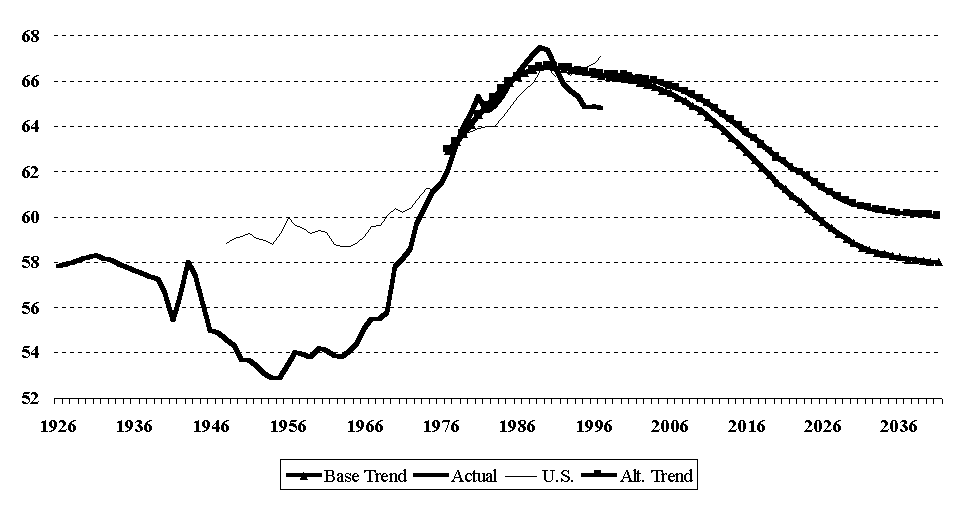
An alternative scenario, in which the participation rates of older Canadians—aside
from females aged 55 to 64—increase gradually to close all of
their actual gaps with comparable U.S. rates by 2040 is also presented
in Chart 1. Assuming that older Canadians will increase their participation
in the labour market in the coming decades reduces somewhat the extent
of the fall in the aggregate participation rate but does not change the
overall conclusion of the analysis. By 2040, the participation rate in
the alternative scenario is 60 per cent, compared to 58 per cent in the
basecase scenario.
-
On the U.S. Experience
In contrast to the Canadian economy, the U.S. economy experienced a slight
increase in its aggregate participation rate in the 1990s, from 66.5 per
cent in 1990 to 67.1 per cent in 1997. This suggests that, in contrast
to the Canadian economy, the U.S. economy has not experienced any decline
in its trend participation rate. The application to U.S. data of the same
methodology we have used for Canada suggests that the divergence in their
structural participation rates reflects in large part divergence in their
recent demographic evolutions.
A comparison of the demographic composition effect in Canada and the
U.S. between 1960 and 2010 is presented in Table 5. As it is the case in
Canada, the demographic composition effect tended to subtract from the
aggregate participation rate since the 1950s and will continue to do so
in coming years. However, the magnitude of the demographic composition
effect differs in the two countries depending on the period considered.
In the 1950s and 1960s changes in the age composition of the population
were exerting more downward pressures on the aggregate participation rate
in the U.S. than in Canada. In the 1970s demographics began to have less
of an impact on the participation rate in the U.S. than in Canada. Indeed,
in the 1980s, changes in the age composition of the population added
0.7 per cent to the U.S. participation rate, while they removed
0.3 percentage point to the Canadian participation rate.
Table 5
Annual Average Demographic Composition Effect, Canada
and the U.S., 1950-2010
(Percentage points) 1
| Period |
Canada |
U.S. |
| 1950-1960 |
-0.048 |
-0.204 |
| 1960-1970 |
-0.105 |
-0.135 |
| 1970-1980 |
-0.008 |
-0.001 |
| 1980-1990 |
-0.032 |
0.073 |
| 1990-2000 |
-0.119 |
-0.022 |
| 1990-1997 |
-0.116 |
-0.010 |
| 1997-2000 |
-0.127 |
-0.048 |
| 2000-2010 |
-0.210 |
-0.151 |
1 The demographic composition
effect for the U.S. was calculated by holding the participation rates for
the 14 individual age-sex groups constant at their 1989 values, and aggregating
them using civilian population weights. For each cohort, the civilian population
was obtained as the ratio of the labour force to the participation rate.
Because of data availability, the two older cohorts—65 to 69 and 70 and
over—were combined together, reducing the number of cohorts to 14.
The demographic composition effect continued in the 1990s to affect
the Canadian economy more than the U.S. economy. While the demographic
composition effect removed almost 1 percentage point to the Canadian participation
rate between 1990 and 1997, it has removed less than 0.1 percentage point
to the U.S. rate. As in Canada, the composition of the U.S. source population
shifted from those aged under 34 to those aged 35 and over during the 1990s.
In contrast to the Canadian experience, however, the change in age-sex
composition of the source population in the U.S. exerted almost no downward
pressures on the aggregate participation rate. This is because Canada experienced
a much larger increase in the proportion of the source population aged
65 and over than the U.S. in the 1990s. The proportion of the source population
aged 65 and over increased 1.3 percentage points in Canada between 1989
and 1996, but increased only 0.2 percentage point in the U.S. (Table A2
in the Annex).
The divergence in the timing of the demographic composition effect between
the U.S. and Canada reflects the fact that the U.S. became an older society
faster than Canada. Between 1950 and 1970, the proportion of the population
aged 65 and over increased from 10.8 per cent to 13.9 per cent in the U.S.,
whereas in Canada it increased only from 10.9 per cent to 11.4 per cent.
In the 1970s the share of older people in the population began to increase
more rapidly in Canada, allowing an almost complete catch-up to the U.S.
level. Between 1970 and 1997, the proportion of the population aged 65
and over increased from 11.4 per cent to 15.3 per cent in Canada, while
it increased only from 13.9 per cent to 15.8 per cent in the U.S.
Looking ahead, the demographic composition effect will also increase
in the U.S. but will remain less of a drag on the aggregate participation
rate than in Canada. This reflects the fact that Canada is expected to
become an older society than the U.S. with its share of those aged 65 and
over in the population increasing to 16.7 per cent by 2010, compared to
16.1 per cent in the U.S.
7. Concluding Remarks
Clearly, the respective roles of cyclical and structural factors underlying
the evolution of participation rates is the subject of considerable uncertainty,
but we hope to have highlighted the issue by using a simple population
accounting framework. We have focused on demographic changes that are the
most certain component of any participation projection. In that respect,
the conventional wisdom is that the ageing of the population will start
to dampen the aggregate participation rate only around 2010 when the leading
edge of the "baby boom" generation will start to retire. In contrast, our
results indicate that the retirement of "baby boomers" will not start but
rather intensify a downward trend in aggregate participation related to
longer life expectancy.
As a result, our calculations suggest that the structural participation
rate has been trending down since 1989 and will continue to do so in coming
decades. Although our estimated trend participation rate is dependent on
the assumptions underlying individual trend participation rates or the
population projection, the overall downward profile obtained in this paper
is robust with respect to any set of plausible assumptions.
As noted in the introduction, the current value of the trend participation
rate has some short-term implications for the conduct of fiscal and monetary
policies. In that respect, it is important to know if our current estimate
of the aggregate participation rate is "optimistic" or "pessimistic". A
check on our results suggests that our estimate of the trend participation
rate may be "too" optimistic. Since the third quarter of 1996 and for 6
quarters in a row real GDP growth has averaged 4 per cent at annual rate,
the unemployment rate has fallen almost 1.5 percentage points (reversing
almost 40 per cent of the increase in the early 1990s), while the aggregate
participation rate has been relatively stable at about 64.8 per cent. This
may suggest that the Canadian structural participation rate is already
below 66 per cent. This may be viewed as a positive or a negative development.
On the negative side, a lower trend participation rate means a lower output
gap and less room to grow in the near term. On the positive side, a lower
trend participation rate may suggest a more substantial fall in
the unemployment rate in coming years for a given path in growth.
The fact that Canadians are less likely to participate in the labour
market with the passage of time has direct implications for the design
of current and future policies. This is because most feasible policies
will affect participation only with long lags—education, social programs,
pension systems. Considering pension systems for example, it is probably
not just a question reducing economic incentives to early retirement but
also moving towards a more flexible labour market in which gradual retirement
is possible rather than "forcing" workers into the binary choice of working
full time or not working at all. In that respect, additional economic research
should be devoted to understanding the determinants of labour market participation
of various demographic groups and particularly older people aged 55 and
over, who will account for 40 per cent of the population in thirty years.
Foot Notes
1 The views expressed in this paper are those of the authors
and should not be attributed to the Department of Finance.
2 It is important for these groups to use 5-year cohorts because the
significant differences in their participation rates gives a richer
estimate of demographic effects.
3 The medium growth population projection, which covers the 1993 to
2041 period, encompasses the following assumptions. First, the fertility
rate remains constant at 1.7 children per woman over the entire forecast
horizon. Second, life expectancy at birth increases from 74.6 years and
80.9 years in 1991 to 78.5 years and 84 years in 2016 for males and
females, respectively. After 2016, life expectancy is assumed to
remain constant at levels of 2016. Third, the annual number of
immigrants remains constant at its 1993 level of 250,000 over the
entire projection period.
4 In these studies, the participation rate is regressed on both structural
and cyclical variables. The estimated relationship is then used to purge
cyclical effects from the actual participation rate and obtain an estimation
of the structural or trend participation rate. Some of these studies use
the employment-to-population ratio as a measure of job opportunities or
business cycles. As noted below, the results of these studies are difficult
to interpret because the employment-to-population ratio should in principle
capture cyclical as well as structural effects.
5 In calculating the demographic composition effect over
the 1921 to 2040 period different population weights were used in different
sub-periods because of data availability. First, for the 1921 to 1975 period,
population data from CANSIM were used. Second, over the 1976 to 1997 period
labour force source population data from the Labour Force Survey were used.
Because population data was used to calculate the composition effect prior
to 1976, the series calculated between 1921 and 1975 was scaled by the ratio
of the demographic composition effect calculated with population weights to
the one calculated with source population weights in 1976. Finally, for the
projection, source population for each age-sex cohort was estimated by
scaling each cohort's population projected by Statistics Canada by its
source population-to- population ratio in 1997.
6 As noted in the previous section, this issue has
been analysed by only few studies, however.
7 The expected impact of higher relative minimum
wages on youth participation rates in uncertain since it affects both
the supply and demand of young workers.
8 The same argument may apply to higher private
education costs in the U.S. than in Canada.
9 For Canada the school enrolment rate is for those
aged 15 to 24 and includes those attending school full-time as well as
part-time. For U.S. the school enrolment rate is for those aged 16 to 24.
10 They obtain this result by assuming that the
"structural" employment-to-population ratio has not changed since 1989.
It is interesting to note that this implies a natural rate of unemployment
of about 5.5 per cent.
References
Archambault, Richard and Louis Grignon, The decline in the Youth
Participation Rate: Structural or Cyclical?, Department of Human Resources
Development mimeo, 1998.
Fortin, Pierre and Mario Fortin, Les d?terminants du taux d’activit?
au Canada: une approche par groupes d?mographiques et par r?gions,
Communication pr?sent?e au congr?s de la SCSE, ?cole des hautes ?tudes
commerciales, 1997.
Gruber, Jonathan and Bridgitte C. Madrian, Health Insurance and the
Retirement Decision, American Economic Review, September 1995, pg.
938-948.
Haritos, Janice, Labour Force Participation: A Canada – U.S. Comparison,
Department of Finance Canada, mimeo, March 1998.
Ip, Irene, Sheryl King and Genevi?ve Verdier, Recent Patterns of
Participation Rates: A Canada – U.S. Comparison, Bank of Canada, Unpublished
Paper, 1997.
Italiano, Joe, Public and Private Pensions Plans, Wealth and the Declining
Participation Rate of Older Workers, Department of Finance Canada, mimeo,
April 1996.
Jennings, Philip, What is Behind the Declining Youth Participation
Rate?, Applied Research Bulletin, Vol. 3 No. 2, Department of Human
Resources Development Canada, Summer-Fall 1997.
MacGregor, Mary and Kurt Mang, Long-Term Participation Rate Projections,
Department of Finance Canada, mimeo, April 1996.
Rose, Graham, Student Enrolment and Youth Participation Rate,
Department of Finance mimeo, December 1994.
Rubin, Jeff and John Lester, Unemployment in Canada: Understated
and Not Falling Fast, Wood Gundy Economics, Monthly Indicators, March
1997, pg. 5-8.
Table A1: Detailed Demographic Composition Effect, Canada, 1989-1996
| |
1989 Participation Rate
(1) |
1989 Source Population Weights
(2) |
1989 Contribution to Aggregate Participation
Rate
(1)*(2) |
1996 Source Population Weights
(3) |
1996 Contribution to Aggregate Participation
Rate with 1989 Cohort Rates
(3)*(1) |
1989-1996 Changes in Weights
(4)=(3)-(2) |
Contribution to the Change in Aggregate Participation
Rate with fixed 1989 cohort rates
(5)=(4)*(1) |
Cumulative Contribution
S (5) |
| Men 15-19 |
60.6 |
4.59 |
2.78 |
4.30 |
2.61 |
-0.29 |
-0.18 |
-0.18 |
| Women 15-19 |
56.7 |
4.42 |
2.51 |
4.10 |
2.32 |
-0.32 |
-0.18 |
-0.36 |
| Men 20-24 |
84.9 |
5.11 |
4.34 |
4.30 |
3.65 |
-0.80 |
-0.68 |
-1.04 |
| Women 20-24 |
77.6 |
5.01 |
3.89 |
4.22 |
3.27 |
-0.80 |
-0.62 |
-1.66 |
| Men 25-34 |
94.1 |
11.82 |
11.12 |
10.19 |
9.58 |
-1.63 |
-1.54 |
-3.19 |
| Women 25-34 |
76.5 |
11.73 |
8.98 |
10.14 |
7.76 |
-1.59 |
-1.22 |
-4.41 |
| Men 35-44 |
94.7 |
9.78 |
9.26 |
10.60 |
10.04 |
0.82 |
0.78 |
-3.63 |
| Women 35-44 |
77.2 |
8.78 |
7.55 |
10.65 |
8.22 |
0.87 |
0.67 |
-2.96 |
| Men 45-54 |
91.7 |
6.59 |
6.05 |
8.10 |
7.43 |
1.51 |
1.38 |
-1.57 |
| Women 45-54 |
67.6 |
6.55 |
4.43 |
8.09 |
5.47 |
1.54 |
1.04 |
-0.53 |
| Men 55-64 |
66.2 |
5.53 |
3.66 |
5.31 |
3.52 |
-0.22 |
-0.15 |
-0.68 |
| Women 55-64 |
34.4 |
5.79 |
1.99 |
5.45 |
1.88 |
-0.34 |
-0.12 |
-0.80 |
| Men 65-69 |
17.0 |
2.22 |
0.38 |
2.26 |
0.38 |
0.03 |
0.01 |
-0.79 |
| Women 65-69 |
7.6 |
2.67 |
0.20 |
2.50 |
0.19 |
-0.17 |
-0.01 |
-0.80 |
| Men 70+ |
7.1 |
3.46 |
0.25 |
4.04 |
0.29 |
0.57 |
0.04 |
-0.76 |
| Women70+ |
2.2 |
4.94 |
0.11 |
5.76 |
0.13 |
0.82 |
0.02 |
-0.75 |
| Total |
67.48 |
100.00 |
67.48 |
100.00 |
66.73 |
0.00 |
-0.75 |
-- |
Table A2: Detailed Demographic Composition Effect, United States, 1989-1996
| |
1989 Participation Rate
(1) |
1989 Source Population Weights
(2) |
1989 Contribution to Aggregate Participation
Rate
(1)*(2) |
1996 Source Population Weights
(3) |
1996 Contribution to Aggregate Participation
Rate with 1989 Cohort Rates
(3)*(1) |
1989-1996 Changes in Weights
(4)=(3)-(2) |
Contribution to the Change in Aggregate Participation
Rate with fixed 1989 cohort rates
(5)=(4)*(1) |
Cumulative Contribution
S (5) |
| Men 15-19 |
57.8 |
3.83 |
2.21 |
3.79 |
2.19 |
-0.05 |
-0.03 |
-0.03 |
| Women 15-19 |
54.0 |
3.80 |
2.05 |
3.66 |
1.97 |
-0.14 |
-0.08 |
-0.10 |
| Men 20-24 |
85.2 |
4.69 |
4.00 |
4.29 |
3.66 |
-0.40 |
-0.34 |
-0.44 |
| Women 20-24 |
72.4 |
4.98 |
3.61 |
4.39 |
3.18 |
-0.59 |
-0.43 |
-0.87 |
| Men 25-34 |
94.5 |
11.31 |
10.68 |
9.86 |
9.31 |
-1.45 |
-1.37 |
-2.24 |
| Women 25-34 |
73.5 |
11.68 |
8.58 |
10.21 |
7.50 |
-1.47 |
-1.08 |
-3.32 |
| Men 35-44 |
94.5 |
9.43 |
8.92 |
10.58 |
10.00 |
1.14 |
1.08 |
-2.24 |
| Women 35-44 |
76.0 |
9.87 |
7.50 |
10.90 |
8.28 |
1.03 |
0.78 |
-1.45 |
| Men 45-54 |
91.1 |
6.43 |
5.86 |
7.81 |
7.12 |
1.38 |
1.26 |
-0.19 |
| Women 45-54 |
70.5 |
6.85 |
4.82 |
8.22 |
5.80 |
1.38 |
0.97 |
0.78 |
| Men 55-64 |
67.2 |
5.42 |
3.64 |
4.98 |
3.35 |
-0.43 |
-0.29 |
0.49 |
| Women 55-64 |
45.1 |
6.07 |
2.74 |
5.48 |
2.47 |
-0.59 |
-0.27 |
0.22 |
| Men 65+ |
16.6 |
6.51 |
1.08 |
6.65 |
1.11 |
0.14 |
0.02 |
0.24 |
| Women 65+ |
8.3 |
9.14 |
0.76 |
9.18 |
0.77 |
0.04 |
0.00 |
0.25 |
| Total |
66.45 |
100.00 |
66.45 |
100.00 |
66.70 |
0.00 |
0.25 |
-- |
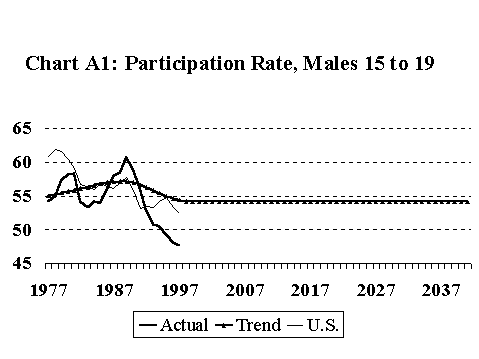
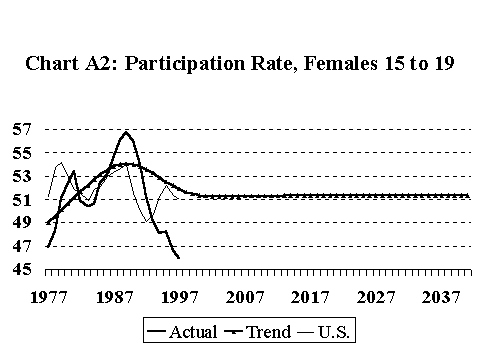
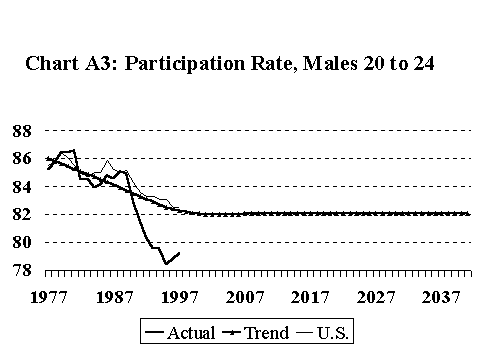
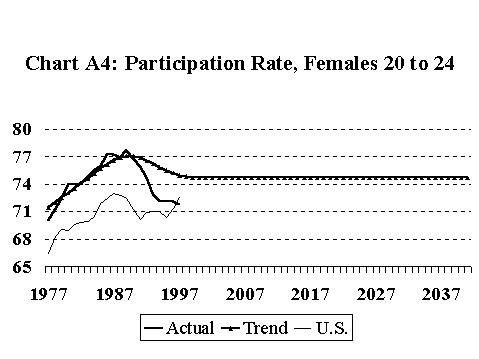
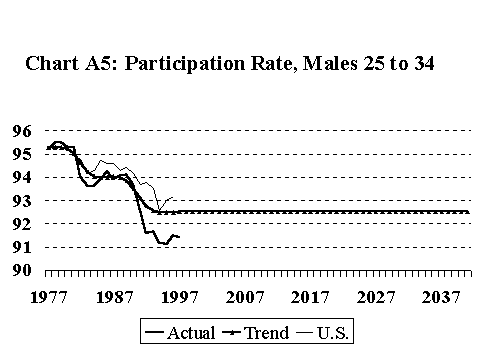
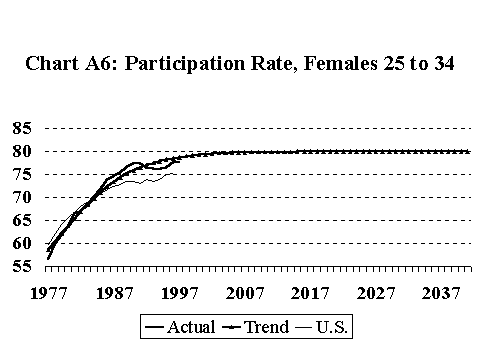

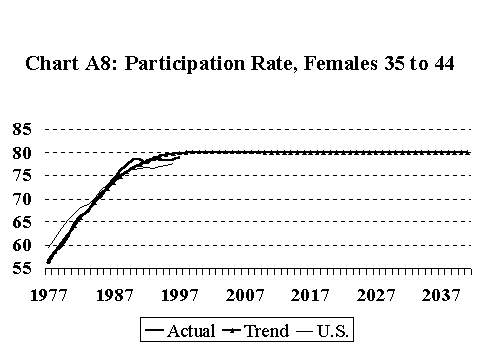
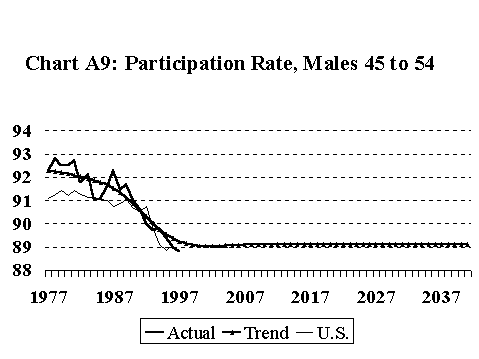


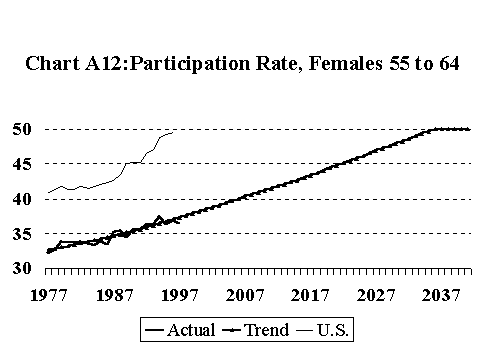


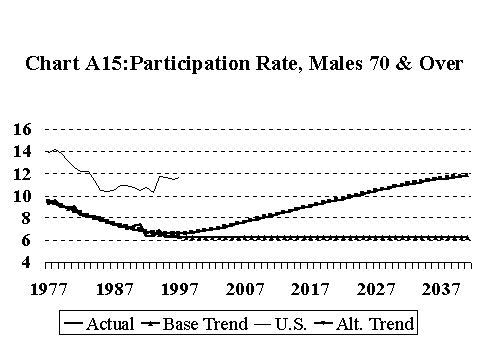
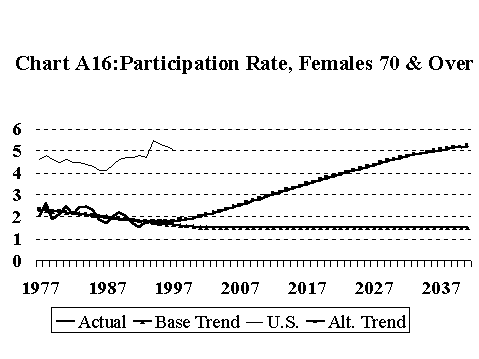
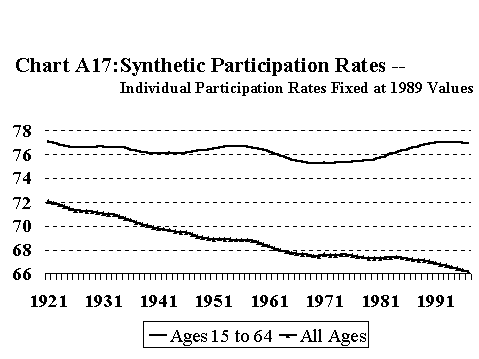

|